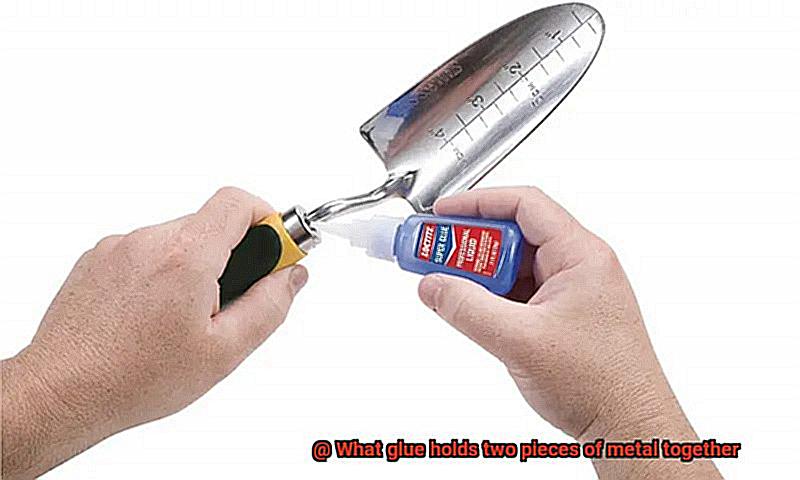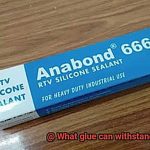Gasoline and glue may not seem like a likely pair, but in industries where fuel leaks and spills are lurking dangers, finding an adhesive that can stand up to gasoline’s corrosive clutches is crucial. Welcome to our blog post, where we dive deep into the world of gasoline-resistant glue – a lesser-known yet vital topic that holds the key to secure and durable bonds in petrol-based environments.
From repairing fuel tanks to sealing fuel lines and gaskets, the durability of an adhesive when exposed to gasoline is paramount. Join us as we unlock the secrets behind these remarkable glues that defy the destructive forces of gasoline and other hydrocarbons. We’ll explore their properties, applications, and benefits, shedding light on how they revolutionize industries like automotive and aerospace.
With decades of industrial experience under our belt and a wealth of research at our fingertips, we’re here to provide you with valuable insights and tips for navigating the maze of adhesive options available for gasoline-filled environments. Discover how these game-changing glues have transformed the way critical connections are made – ensuring safety, reliability, and longevity in gasoline-rich settings.
So buckle up. Get ready for a fascinating journey into the world of gasoline-resistant glue – a secret ingredient that guarantees not only strong bonds but also the preservation of lives.
Types of Adhesives Suitable for Gasoline
Contents
- 1 Types of Adhesives Suitable for Gasoline
- 2 Benefits of Using Epoxy Adhesives
- 3 The Advantages of Polyurethane-Based Adhesive
- 4 Super Glue: Pros and Cons
- 5 Bond Strength When Exposed to Gasoline
- 6 Manufacturer’s Instructions for Maximum Bond Strength
- 7 Testing the Adhesive in a Controlled Environment
- 8 Mechanical Fastening Methods for Gasoline Resistance
- 9 Conclusion
The secret lies in choosing the right adhesive. Not all glues are created equal, especially when it comes to withstanding the harsh effects of gasoline. In this article, we will explore the various types of adhesives suitable for use with gasoline, empowering you to make informed decisions for your projects.
Epoxy – The Unyielding Powerhouse:
When it comes to creating strong bonds that can resist gasoline, epoxy adhesives reign supreme. Composed of a resin and a hardener, epoxy creates a formidable and long-lasting bond that can withstand exposure to gasoline. Whether you’re repairing metal components or sealing fuel tanks, epoxy is your ultimate adhesive solution.
Polyurethane – The Champion of Chemical Resistance:
Polyurethane adhesives are renowned for their exceptional resistance to solvents and chemicals, making them ideal for gasoline-related applications. With excellent flexibility and a bond that stubbornly holds even under high stress, polyurethane adhesives ensure your project remains intact in the face of adversity.
Silicone – Flexibility and Temperature Resilience:
Silicone adhesives are celebrated for their remarkable flexibility and ability to withstand extreme temperatures. While not all silicone adhesives are resistant to gasoline, specific formulations are available that offer this level of protection. If you require an adhesive that can handle both gasoline exposure and temperature fluctuations, silicone is your go-to choice.
Cyanoacrylate – Super Glue’s Astonishing Secret:
Prepare to be amazed. Certain cyanoacrylate adhesives, commonly known as super glue, can provide some resistance to gasoline. These fast-drying adhesives create an instant bond that holds up well in certain gasoline-related applications. However, it is crucial to select a cyanoacrylate adhesive specifically designed for gasoline resistance or consult the manufacturer to ensure its suitability.
Specialized Gasoline-Resistant Adhesives:
In addition to the aforementioned types, specialized adhesives formulated explicitly for gasoline-related applications are available. These adhesives possess enhanced resistance to chemical degradation caused by prolonged gasoline exposure.
Consulting with adhesive manufacturers or suppliers will help you identify the most suitable product for your specific project, ensuring an unbreakable bond.
Discovering the perfect adhesive for gasoline-related applications is essential in maintaining strong bonds in harsh environments.
Epoxy, polyurethane, silicone, and certain cyanoacrylate adhesives offer varying levels of resistance to gasoline, guaranteeing your projects remain intact even when faced with this volatile fuel.
Remember to diligently follow manufacturer instructions, prepare surfaces properly, and consider factors like temperature range and duration of gasoline exposure for optimal results.
Benefits of Using Epoxy Adhesives
When it comes to tackling projects involving gasoline, the choice of adhesive is crucial. Epoxy adhesives, the unsung heroes of the glue world, offer a range of benefits that make them the ideal solution for gasoline-related applications.
In this article, we will explore the exceptional chemical resistance, strength and durability, versatility, and other advantages of using epoxy adhesives in gasoline-related projects. So grab a cup of coffee and let’s dive into the world of epoxy adhesives.
Exceptional Chemical Resistance:
Epoxy adhesives are renowned for their ability to resist chemicals, making them perfect for applications involving gasoline. Their molecular structure creates a barrier against the corrosive effects of gasoline, ensuring that your bonds remain strong and intact even in the harshest conditions.
Strength and Durability:
In the battle against stress and vibrations, epoxy adhesives emerge victorious. They create robust and durable bonds that can withstand the rigorous demands of gasoline-related projects. Whether you’re repairing a gas tank or securing fuel lines, epoxy adhesives provide unwavering strength, ensuring long-lasting and reliable results.
Resistance to Temperature Fluctuations:
Gasoline-related environments can experience extreme temperature fluctuations. Luckily, epoxy adhesives are up to the challenge. They offer excellent resistance to both hot and cold environments, ensuring that your bonds remain reliable and secure regardless of temperature changes.
Consistency and Reliability:
Unlike some other adhesives, epoxy does not shrink or expand significantly when exposed to gasoline. This consistency ensures that your bonds remain reliable over time, eliminating the risk of leaks or failures. With epoxy adhesives, you can have peace of mind knowing that your project will stand the test of time.
Moisture and Humidity Resistance:
Gasoline often contains water vapor, which can pose challenges for adhesives. However, epoxy adhesives excel in resisting moisture and humidity, providing added protection in gasoline-related applications. This resistance ensures that your bonds remain strong and unaffected by the presence of water vapor.
Versatility:
Epoxy adhesives are incredibly versatile, capable of bonding a wide range of materials found in gasoline-related projects. Whether you’re working with metals, plastics, ceramics, or composites, epoxy adhesives have got you covered. This versatility makes them the go-to choice for various applications, simplifying the adhesive selection process.
Mechanical Strength and Impact Resistance:
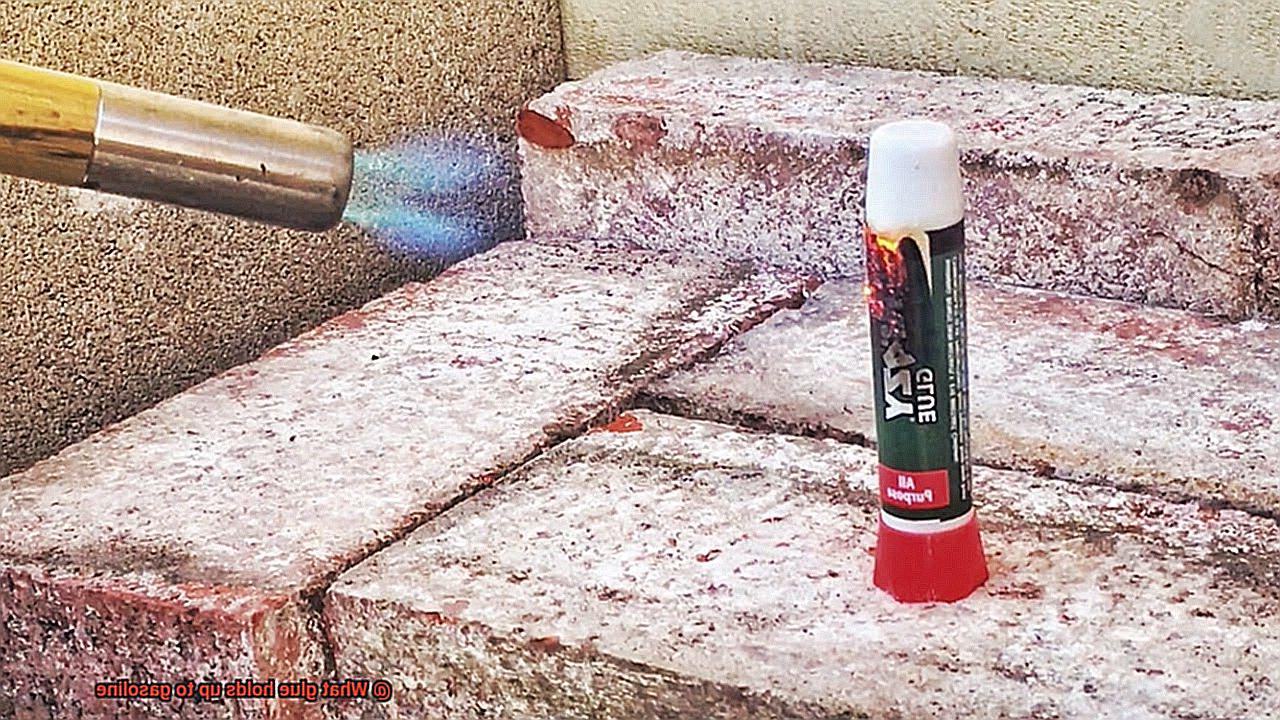
When it comes to gasoline-related projects, durability is key. Epoxy adhesives offer excellent mechanical strength and impact resistance, ensuring that your bonded parts can withstand the stresses and strains associated with gasoline exposure. This strength and resilience make epoxy adhesives the reliable choice for demanding applications.
The Advantages of Polyurethane-Based Adhesive
Polyurethane-based adhesive is a remarkable glue that offers numerous advantages, particularly in its resistance to gasoline. Its exceptional bonding strength is the first advantage that sets it apart from other glues. This adhesive creates robust and long-lasting bonds between different surfaces, making it the go-to choice for applications that demand durability.
But wait, there’s more. Unlike other glues that become rigid and brittle once cured, polyurethane adhesive remains flexible. It can handle vibrations and movements without compromising its bond strength. This flexibility is especially important when dealing with gasoline tanks or containers that experience temperature changes. No matter how much they expand or contract, this adhesive will stay strong.
And let’s not forget about its chemical resistance. Polyurethane-based adhesive laughs in the face of gasoline. Its chemical structure is designed to withstand harsh environments, including the mighty power of gasoline. Whether it’s automotive or industrial applications, you can trust this adhesive to hold up under gasoline contact.
But the advantages don’t stop there. This adhesive also boasts excellent moisture resistance, making it suitable for both indoor and outdoor applications. Rain or shine, it can withstand water exposure, humidity, and even submersion without losing its stickiness.
And what about temperature resistance? From scorching hot summers to freezing cold winters, polyurethane adhesive can handle extreme temperatures without deteriorating. Whether you’re working in a desert or the Arctic, this glue will remain strong.
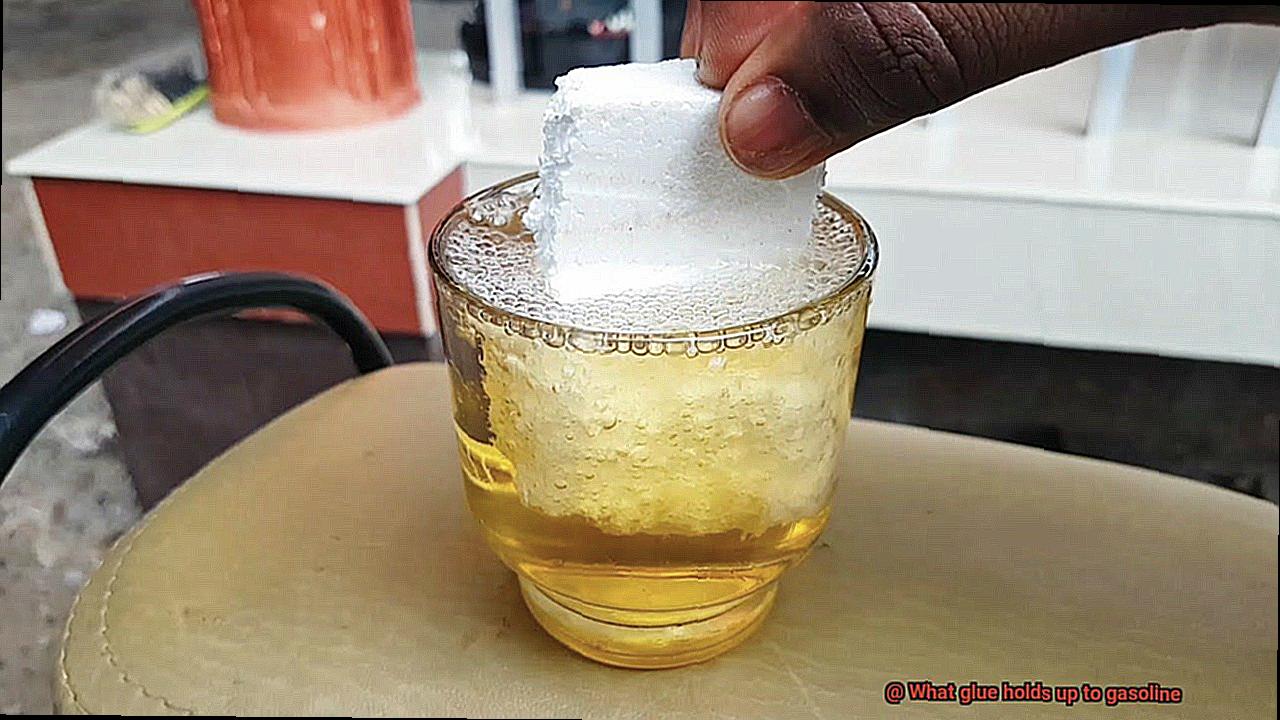
Now let’s talk versatility. Polyurethane-based adhesive can bond a wide range of materials, making it the Swiss Army knife of glues. Whether you’re working with metals, plastics, wood, ceramics, or any other material, this adhesive has got you covered.
Super Glue: Pros and Cons
Super glue, also known as cyanoacrylate adhesive, is a popular type of adhesive that is widely used in various industries and for different applications. When it comes to gasoline resistance, super glue has its pros and cons.
Let’s start with the pros. First up, we have the lightning-fast bonding time of super glue. Seriously, this stuff forms a strong bond within seconds of application, making it perfect for those emergency repairs when time is of the essence. And speaking of emergencies, super glue is incredibly versatile. It can bond a wide range of materials like plastic, metal, rubber, ceramic, and even some types of wood. So whether you’re fixing a broken dashboard or patching up a fuel line, super glue has got your back.
Another major advantage of super glue is its high strength. Once cured, this adhesive forms a super-strong bond that can withstand serious stress and tension. That means you can trust it to hold up under pressure and provide long-lasting results.
Did I mention how easy it is to use? Super glue comes in convenient tubes or bottles with precision applicators, making it a breeze to apply exactly where you need it. Plus, its liquid consistency allows it to seep into even the tiniest gaps and cracks.
Now, let’s talk about the cons. One downside to super glue is its lack of flexibility once cured. Over time, it can become brittle, especially when exposed to temperature changes or vibrations.
So if you’re looking for an adhesive that can handle constant movement or fluctuations in your engine, super glue might not be your best bet.
Another con is its limited gap-filling ability. Unlike some other adhesives like epoxy, super glue works best when the surfaces being bonded fit together tightly without any gaps. If there are significant spaces between the surfaces, the bond may not be as strong or durable.
And here’s the big one: super glue is not resistant to gasoline. Yup, you heard it right. Gasoline contains chemicals that can break down the adhesive, causing it to lose its bonding strength or dissolve completely. So if you’re working on projects that involve gasoline exposure, like fuel system repairs or automotive modifications, it’s best to explore alternative options like epoxy or specialized automotive adhesives.
Bond Strength When Exposed to Gasoline
When it comes to selecting glue for your project, considering its bond strength when exposed to gasoline is vital. Gasoline contains chemicals that can weaken or dissolve certain adhesives, making it crucial to choose a glue that can withstand this challenge. In this blog post, we will explore different types of glues and how their bond strength is affected by exposure to gasoline.
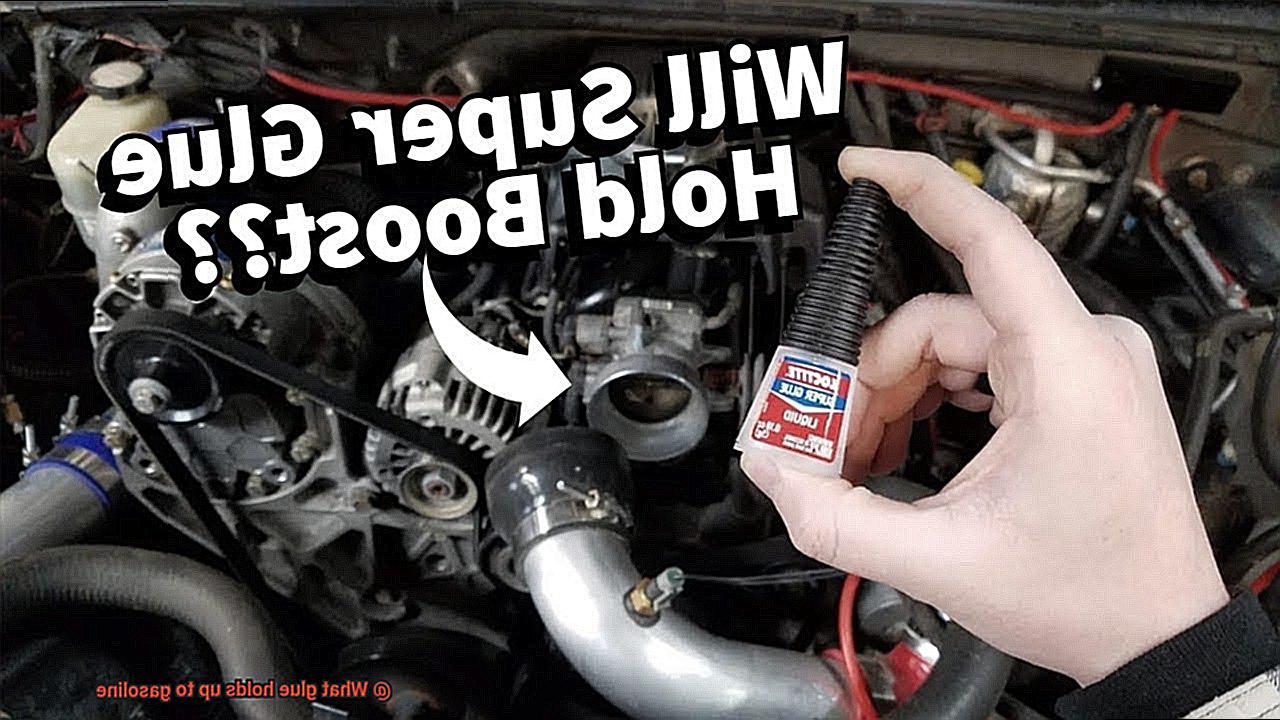
Epoxy Adhesive:
Epoxy adhesives are the superheroes of bonding when it comes to gasoline resistance. Their chemical composition, a dynamic duo of resin and hardener, creates a cross-linked network structure that can withstand solvents like gasoline. Epoxy adhesives are known for their exceptional strength and durability, making them a reliable choice for various applications.
Cyanoacrylate Adhesive:
Cyanoacrylate adhesives, or super glues, offer rapid bonding and strong adhesion. While they can initially withstand exposure to gasoline, prolonged contact may eventually weaken the bond strength over time. So, if you’re looking for quick fixes or temporary bonds in gasoline-exposed areas, super glue could be your go-to adhesive.
Silicone Adhesive:
For applications where flexibility and durability are essential, silicone adhesives are worth considering. They exhibit excellent resistance to solvents and chemicals, including gasoline. Silicone adhesives form flexible and durable bonds that can withstand extreme temperatures and environmental conditions.
Water-Based Adhesive:
On the other hand, water-based adhesives like white glue or wood glue should be avoided in situations involving gasoline exposure. These adhesives primarily consist of water and polymers, which can be easily dissolved or weakened by gasoline. To ensure a strong bond that lasts, opt for more resilient options like epoxy or silicone adhesives.
Manufacturer’s Instructions for Maximum Bond Strength
When it comes to using glue, following the manufacturer’s instructions is absolutely crucial. These instructions provide vital guidance on how to properly use the glue, ensuring that it reaches its full bonding potential. So, let’s dive into why these instructions are so important.
Different instructions for different glues:
- Each type of glue may have specific instructions, so it’s essential to read and understand them before starting any project.
- Instructions typically include information about the application process, drying time, and any additional steps required for optimal results.
Compatibility with surfaces and materials:
- Manufacturer’s instructions specify the recommended surfaces and materials that the glue can effectively adhere to.
- Using an incompatible glue can result in a weak bond or complete failure.
Surface preparation:
- The instructions may provide details about preparing the surfaces before applying the glue, such as cleaning or roughening them.
- Following these preparation steps ensures that the surfaces are ready to receive the adhesive, leading to a stronger bond.
Drying time:
- Adequate drying time is crucial for maximum bond strength.
- Rushing this step can lead to a weaker bond or even adhesive failure.
Clamping or pressure requirements:
- Some manufacturer’s instructions may specify necessary clamping or pressure requirements during the drying process.
- Applying appropriate pressure ensures proper contact between the adhesive and surfaces, resulting in a stronger bond.
Testing the Adhesive in a Controlled Environment
Get ready to immerse yourself in the fascinating process of determining which glue can withstand the power of gasoline. With your lab coats on and safety goggles in place, let’s dive in.
To begin, we need to select a range of glues that are known for their strength and durability. Think heavyweight contenders like epoxy, polyurethane, cyanoacrylate (super glue), and silicone adhesives. These powerhouses are ready to take on any challenge we throw at them.
Once we have our selection of glues, it’s essential to follow the manufacturer’s instructions meticulously. We must prepare the surface properly, ensuring it is clean and free from any contaminants. Then, we apply the chosen adhesive evenly and give it ample time to cure. This meticulous approach guarantees that we achieve the best possible bond.
Now comes the thrilling part – subjecting our adhesive samples to gasoline in a controlled manner. We can choose to either immerse the samples in gasoline or directly apply it to the adhesive surface. It’s like conducting a mini science experiment right in our own adhesive playground.
Throughout the testing period, we’ll make regular observations and measurements. We’ll keep a keen eye out for any changes in appearance or signs of degradation. After all, we want an adhesive that can stand up to gasoline without breaking a sweat.
To test the strength of our adhesive contenders, we’ll employ specialized equipment that applies force. It’s like a tug-of-war for glues. This method allows us to determine which adhesive holds its ground when faced with stress.
However, it’s important to note that not all glues are created equal when it comes to gasoline exposure. Some may dissolve or get damaged by this harsh chemical. That’s why it’s crucial to choose adhesives specifically designed for this purpose. We want our recommendations to be reliable and effective.
Once our testing is complete, we’ll record and analyze the results meticulously. We’ll document any changes in appearance, measure the strength of each adhesive, and compare performance across different adhesive types. It’s all about finding the glue that reigns supreme in the realm of gasoline resistance.
Based on our findings, we can confidently make recommendations about which glue holds up best to gasoline. These recommendations will empower you to make informed decisions when tackling projects that involve gasoline exposure.
Mechanical Fastening Methods for Gasoline Resistance
Today, we embark on an exhilarating expedition to explore the wonders of mechanical fastening methods for gasoline resistance. While glue alone may not be enough to conquer this formidable challenge, these mechanical marvels provide an extra layer of strength and durability to ensure our bonds remain unbreakable in the face of gasoline’s relentless assault.
Screws and Bolts:
Let’s start with the trusty screws and bolts, our reliable comrades in the realm of mechanical fastening. Opt for stainless steel or brass variants, known for their exceptional resistance to gasoline-induced corrosion.
To fortify your gasoline-resistant applications, select fasteners specifically designed for this purpose. Look for coatings or platings that offer enhanced protection against gasoline and other chemicals.
Riveting:
Prepare to be riveted by the next contender in our gasoline resistance arsenal – rivets. These permanent fasteners are championed in industries like automotive and aerospace for good reason. By drilling a hole through the materials and inserting a rivet, we create an unyielding joint. Aluminum or stainless steel rivets are your go-to options, as they can endure prolonged contact with gasoline without losing their mettle.
Snap-Fit Connections:
Now, let’s explore the world of snap-fit connections – a true force to be reckoned with. These ingenious joints rely on interlocking features between mating parts, allowing them to snap together securely. The beauty lies in their simplicity, eliminating the need for adhesives or traditional fasteners while still providing robust connections. Remember to consider material properties and dimensions during design to ensure a snug fit that will withstand gasoline’s challenges.
Welding:
Last but not least, we delve into the art of welding – a technique that brings materials together through heat and pressure. Welding can be a viable option for certain gasoline-resistant applications, but caution must be exercised. Consider material compatibility and the welding process’s potential impact on strength and integrity. Careful selection and technique will ensure a formidable bond that can withstand gasoline’s relentless assault.
dA7gQpHv9vs” >
Conclusion
In conclusion, finding a glue that can withstand the harsh effects of gasoline is no easy task.
But fear not, for there are options available. From epoxy adhesives to industrial-strength cyanoacrylates, these glues have been designed to resist the corrosive nature of gasoline.
So whether you’re working on automotive repairs or fuel-related projects, make sure to choose a glue that can hold up to the challenge.

